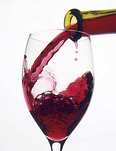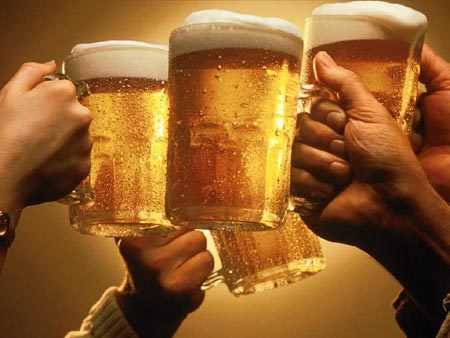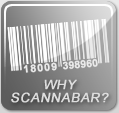Drink Selection: Optimizing Your Liquor Inventory
Cocktails--Reduce Costs While Increasing Customer Satisfaction
 Cocktails are good for profits, and cocktail hour can be serious, big business. The customer feel-good factor is crucial. This can be achieved at no extra cost. Imagination is free.
Cocktails are good for profits, and cocktail hour can be serious, big business. The customer feel-good factor is crucial. This can be achieved at no extra cost. Imagination is free.
- Well brands. Reduce costs by sticking to well brands for cocktails. Don't pour away your profits by using premium brands in cocktail recipes.
- Premium brands. Your establishment might be the sort of outlet that can make big profits out of selling premium brands. If so, use premium or middle-grade ingredients in your cocktails. Take every opportunity to advertise that fact. Emblazon quality brand names across your menus. Also, speak to your suppliers - they may be interested in offering you reduced rates in exchange for some free advertising.
- Signature drinks. Use your imagination and create something really special. Above all, a signature drink must look special. Choose unusual colors. Use different garnishes, such as asparagus, pepperoncini, jumbo shrimp, crab claw or scallions. Stand out from the crowd.
- "Stirred, not shaken." Don't shake mixed drinks that contain carbonated ingredients, particularly if those components are clear liquids. The bubbles will go flat, and the liquids will become cloudy. Stir instead.
- Presentation. Dare to be different. How about serving Chambord on the side for a Meltdown Raspberry Margarita? Let customers pour the liqueur portion themselves. As the liqueur blends into the drink, it will release wonderful aromatic raspberry flavors. It will also look visually stunning. Guests will think, "value."
- Champagne. Many recipes use champagne as a base ingredient. Once opened, a bottle of champagne or sparkling wine becomes a liability, because the bubbles are short-lived. Buy a bottle sealer specifically designed to cope with this problem. Ensure that bartenders know how to use it. You can't afford champagne wastage.
- Ice. Choose a cocktail station that has a deeper-than-average ice bin (up to 15 inches, maximum capacity). Put a divider through the middle of the bin and use it for storing both crushed and cubed ice. When the bar is busy, hanging around waiting for ice supplies costs money.
- Speed. Reposition liquor, wine and soda guns directly above the cocktail station. The soda gun should be placed on the left-hand side of the station, so that the bartender's right hand is free to hold a liquor bottle at the same time. A bartender using both hands is working at top speed and maximum efficiency.
- Perceived value. Improve customer perception of value and quality by increasing the high-cost portion of the cocktail. Up the liquor content to two ounces. Guests will feel they are getting real value for their money; you know this is good for profits.
Trim Liquor Costs
Liquor prices don't vary a great deal from one wholesaler to another. Packaging and size also tend to be fairly consistent. So, what can you do about reducing liquor costs in your operation? The answer is quite a lot! It's a misconception in the liquor trade that your options are limited when it comes to selling liquor. Consider the following opportunities:
- Bulk buys. Purchase staple liquors, such as whiskey, gin, vodka, brandy, rum and other popular spirits (e.g., fruit brandies) in bulk. They have a long shelf life and you know you can sell them within a reasonable period of time.
- Trends. Stay ahead of consumption trends. Respond quickly. For example, the current trend in the United States is toward "light" spirits such as 80-and 86-proof whiskies, instead of 100-proof (50 percent alcohol) bonded whiskies. Wholesalers, too, are keen to promote these alternatives.
- Distilled spirits. Their shelf life is exceptionally long. Buy distilled whenever possible, and minimize wastage.
- Well liquors. Which well liquors you choose can really make a difference in reducing costs. But don't buy at any price and compromise on quality.Your reputation is at stake. Customers often judge an establishment by the quality of its well liquor.
- Call liquors. Increase margins on call liquors (brand names). Guests who ask for Gordon's gin or Jack Daniel's whiskey, for example, are loyal to the brand and will probably not question the price.
Make the Right Choice of Wines

Choice of wine is a very individual matter. There are no rights and wrongs. It is important, however, to pander to customer preferences. Whether you run a bar, restaurant, club or specialized wine bar, you must purchase wine according to the demands of your clientele. If you get it right, profits will soar. But, if you choose wines that aren't a hit with your customers, you end up pouring your profits, as well as the unsold wine, down the drain.
-
Competition. Look at the competition. Keep up to date with which wines are moving well. Read trade journals and publications, such as the "California Wine Growers Institute," to learn more about current trends, or consult the California Association of Wine Grape Growers: 555 University Avenue, Suite 250, Sacramento, CA 95825; www.cawg.org.
-
Regularly review the wine list. Be ruthless - if a wine is slow-moving, remove it from the list.
-
Get ahead of the crowd. Introduce wines from up-and-coming wine regions. Suggestions include: New Zealand Riesling, Gewurztraminer and Sauvignon Blanc for whites, and South African Pinot Noir or Merlot for reds.
-
Storage. Wine is a vulnerable product. One of the most effective ways of reducing costs and avoiding waste is to store wine in the correct environment (temperature, light and ventilation are particularly important). See www.storing-wine.com for handy tips on storing wine.
-
Opened bottles. Establish par levels for each wine stocked behind the bar. Only open as many bottles as you need for one shift. All wines, particularly whites and cheaper house reds, become oxidized and deteriorate quickly once opened. A useful tip is not to pull the cork completely out of the bottle. If a cork is only partly pulled, the wine remains sealed, preventing oxygen from entering the bottle.
-
Cost controls on empty bottles. Count empty wine bottles at the end of each shift. This practice makes sure that bartenders aren't overpouring. For example: you use six 1.5 liter bottles of wine during a shift; your standard portion for wine is 5 ounces; then sales for 60 to 61 glasses should show up on the register tape.
-
Discount premium wines. Discounting premium wines results in a higher potential for profits. It also gives bartenders the opportunity to up-sell customers from standard house wines. This plan works well with "special buys" and wholesaler promotions.
Develop a Successful Beer Program
 Beer is a major seller in most bars, clubs and liquor outlets; it accounts for a hefty percentage of sales. Draft beer is particularly popular. It can prove a lucrative area of any beverage operation, if you get it right. It is estimated that wastage, spillage, excess foam, overpouring, poor quality, theft, giveaways and other draft-beer-related problems can drain your operation of an amazing 20 percent of inventory. Never underestimate the scope for cost reductions in this area!
Beer is a major seller in most bars, clubs and liquor outlets; it accounts for a hefty percentage of sales. Draft beer is particularly popular. It can prove a lucrative area of any beverage operation, if you get it right. It is estimated that wastage, spillage, excess foam, overpouring, poor quality, theft, giveaways and other draft-beer-related problems can drain your operation of an amazing 20 percent of inventory. Never underestimate the scope for cost reductions in this area!
-
Promotions. Beer is a perishable product. As draft beer expires quickly, always consider discounting draft beer before bottled beer.
-
Computer-controlled draft beer technology. A good control system is essential. The best type of control is a flow meter attached to each tap. If your usage is over two kegs per week, then you could justify the installation of an electronic device that counts fractions of an ounce.
-
Foam head. Control the size of the head and really make an impact on cost reductions. A good head of foam is essential, but it is up to you to control the depth of the foam. For example, in a 16-ounce glass, a half-inch head of foam yields around 136 glasses of draft per keg, whereas a one-inch head yields up to 152 glasses per keg. Add up the difference! Train all bartenders to achieve one-inch heads of foam.
-
Stop selling beer in pitchers. Pitchers sell at a lower profit margin than beer by the glass. Although pitchers are a better deal for customers, they do little for your profitability. You're far better off selling four glasses of draft than one pitcher of beer.
This article is an excerpt from the Food Service Professional Guide to Controlling Liquor Wine & Beverage Costs, authored by Elizabeth Godsmark, published by Atlantic Publishing Company. This excerpt has been reprinted with permission of the publisher. To purchase this book go to:







